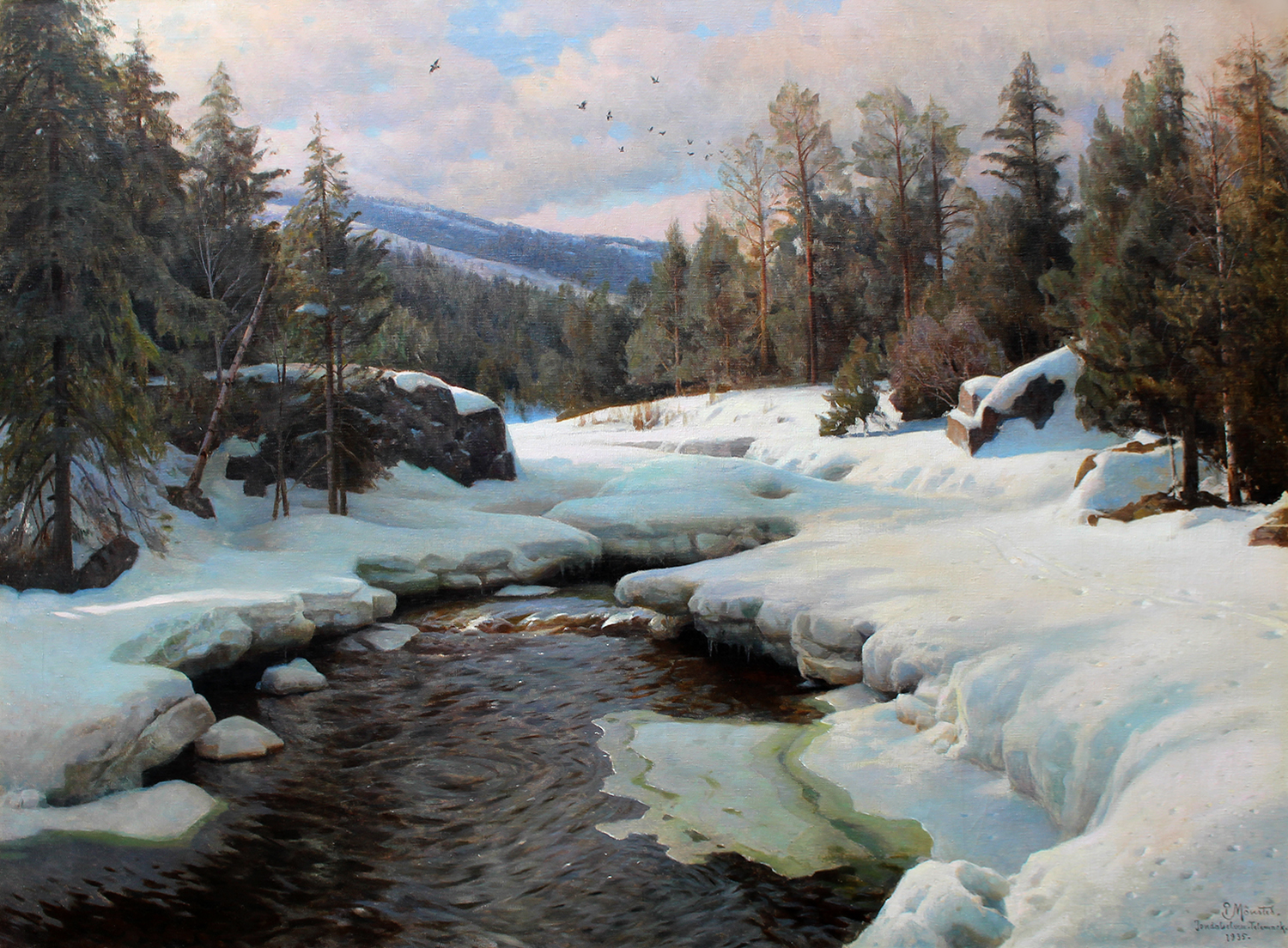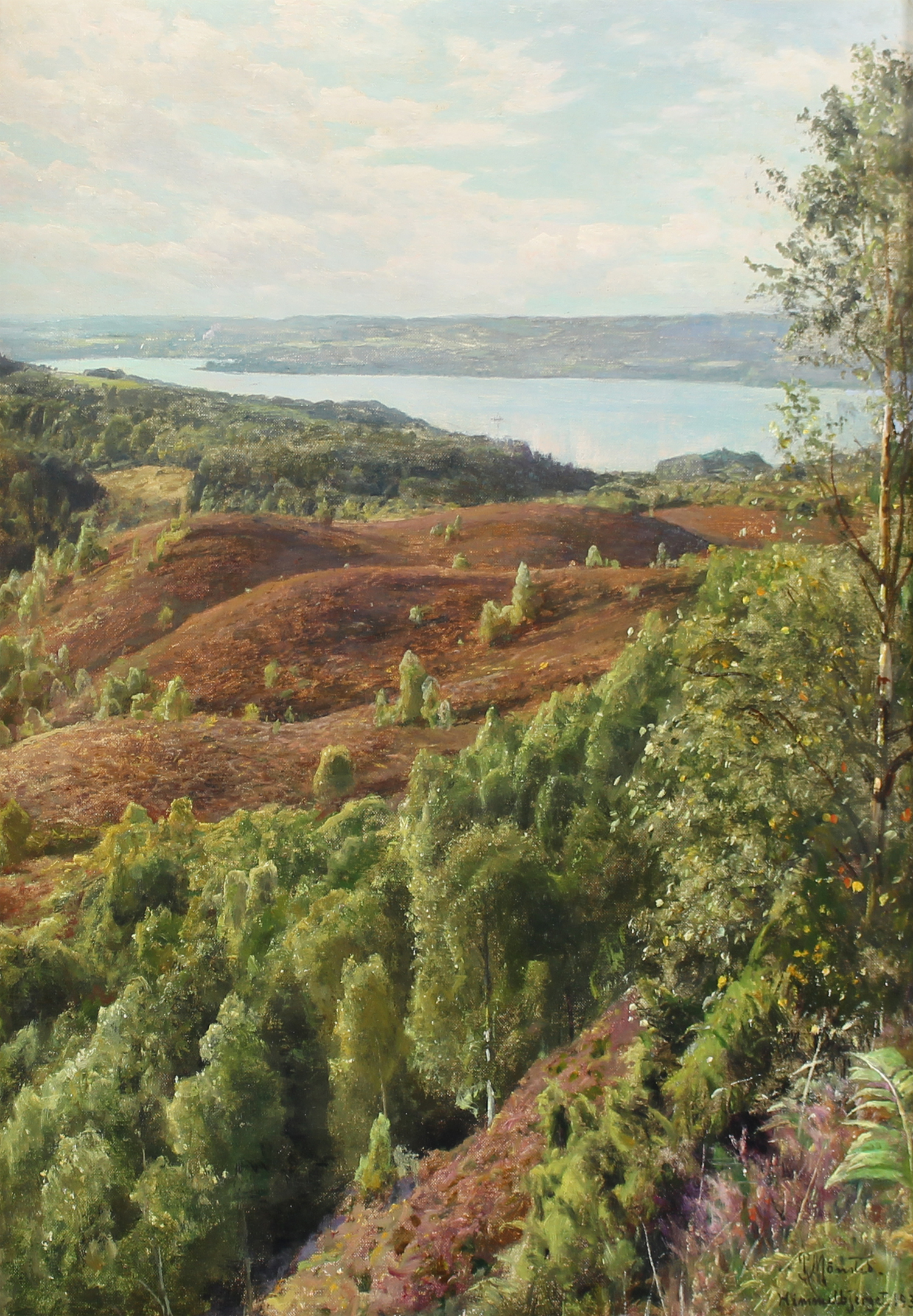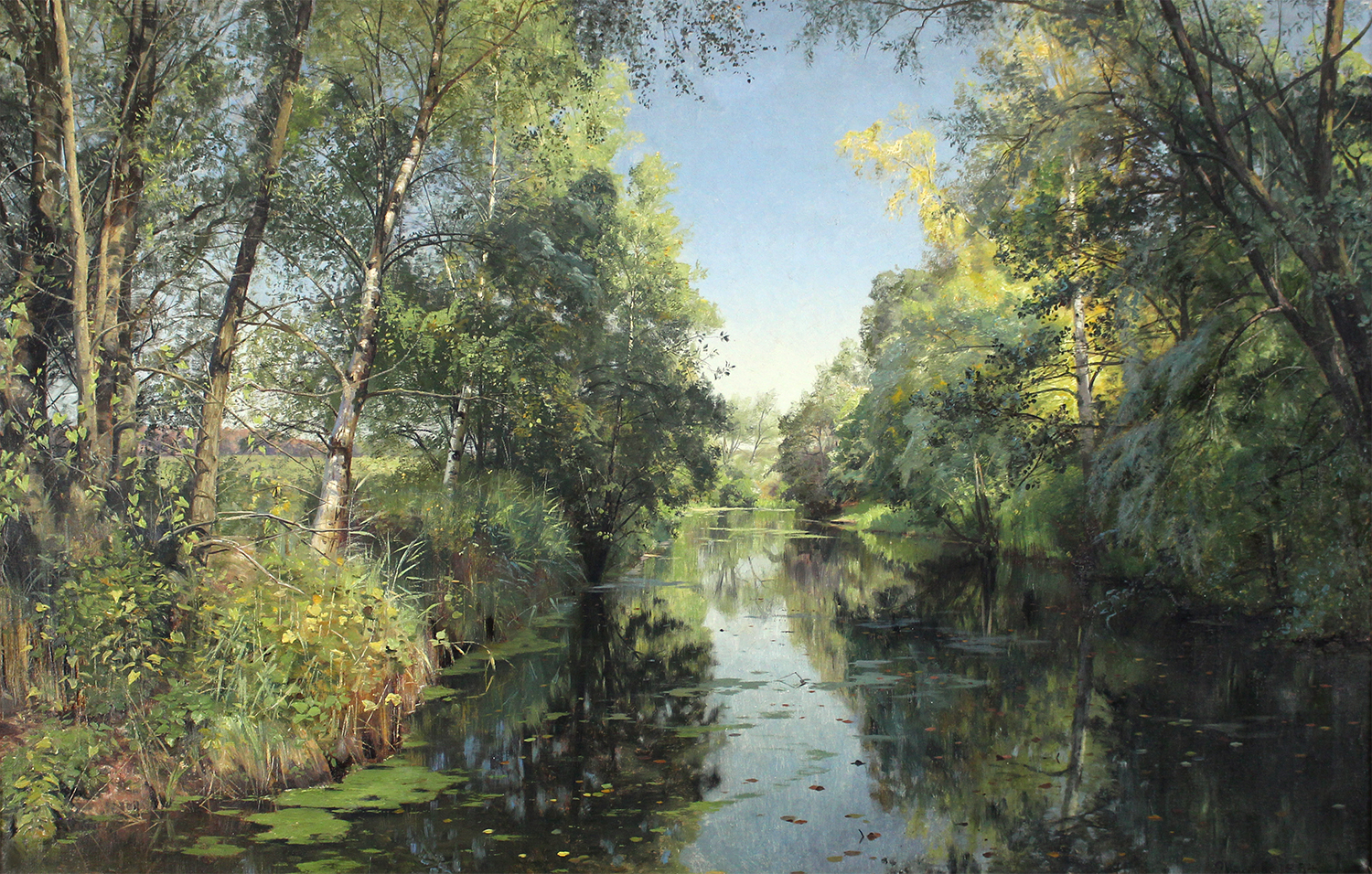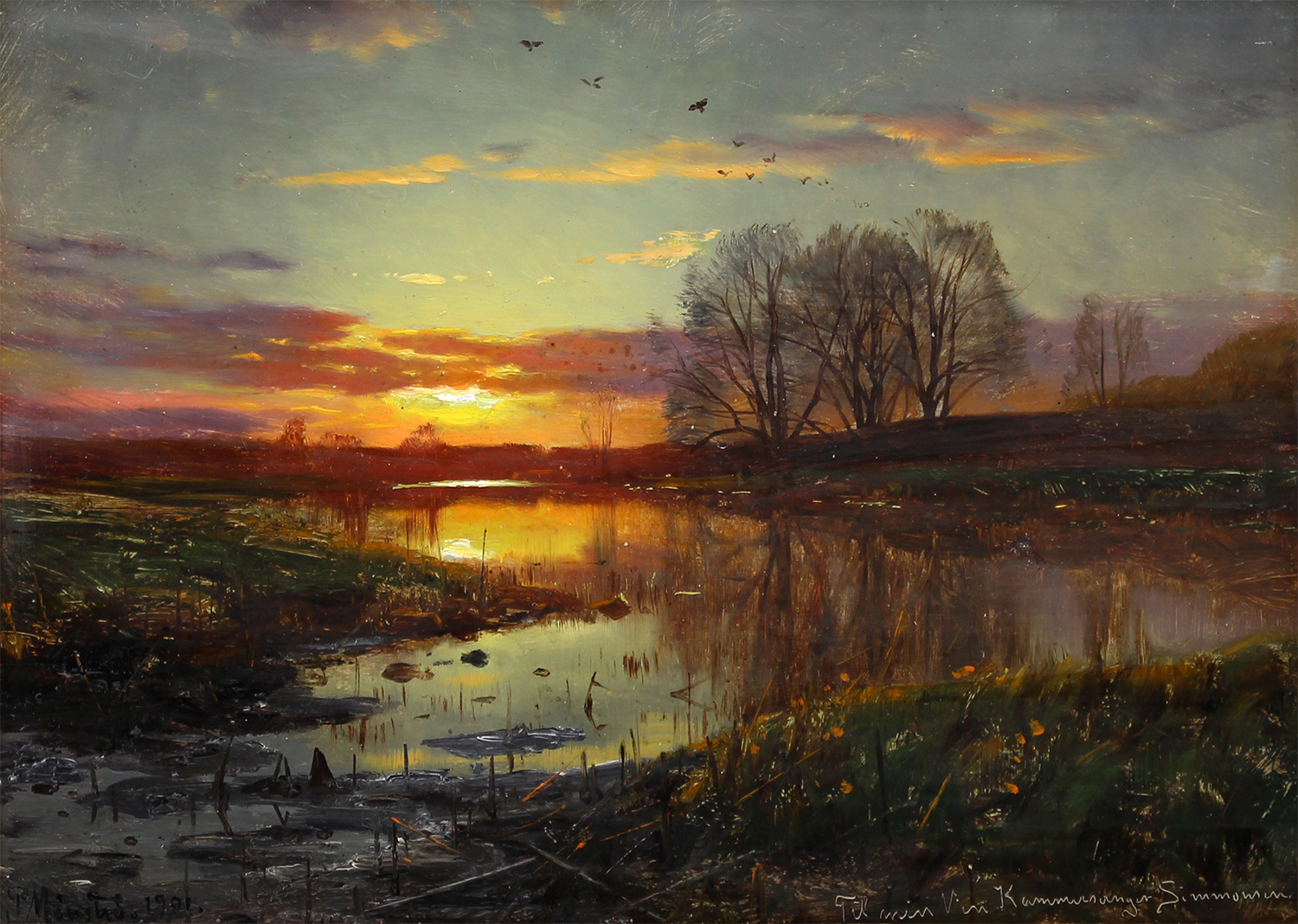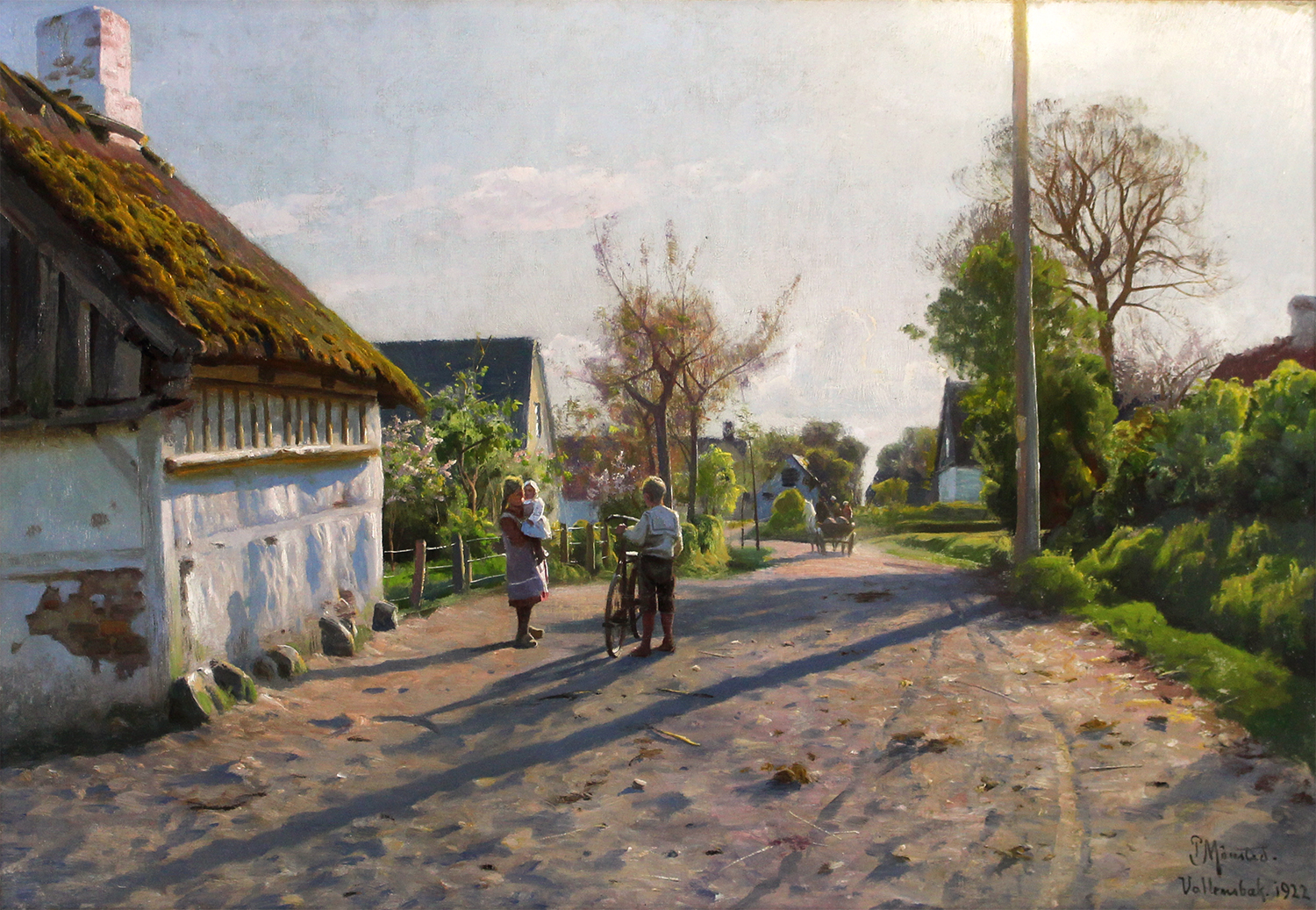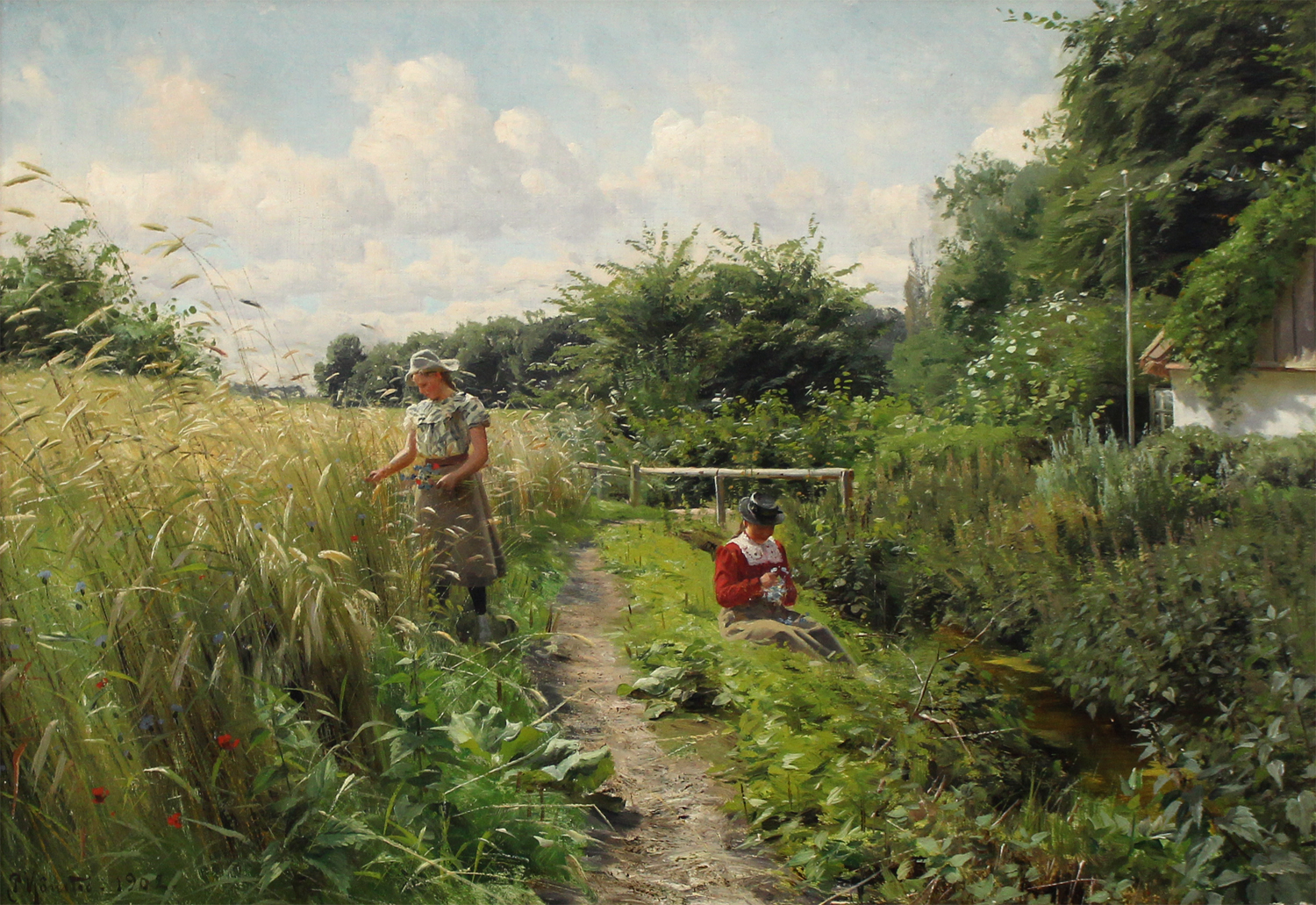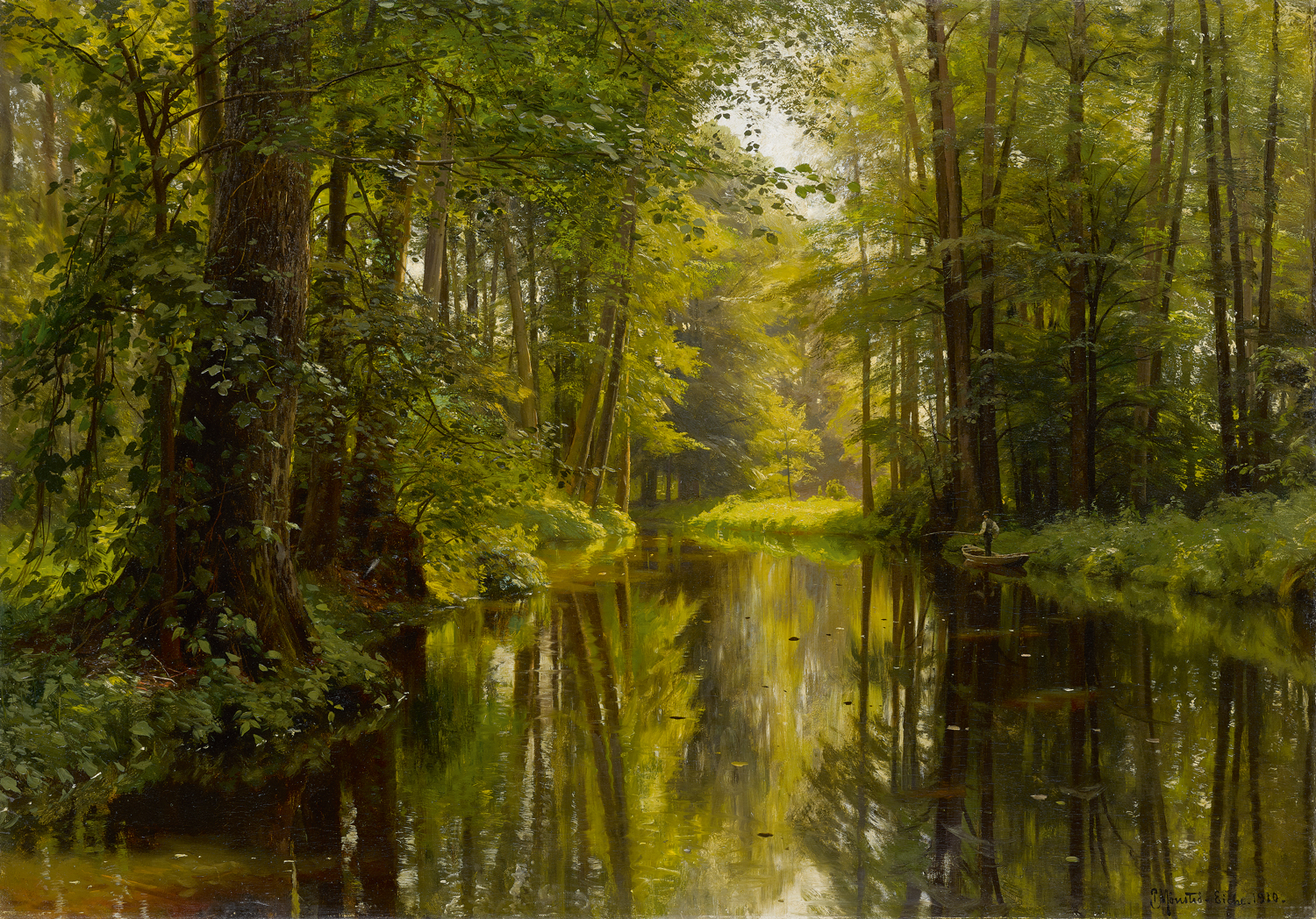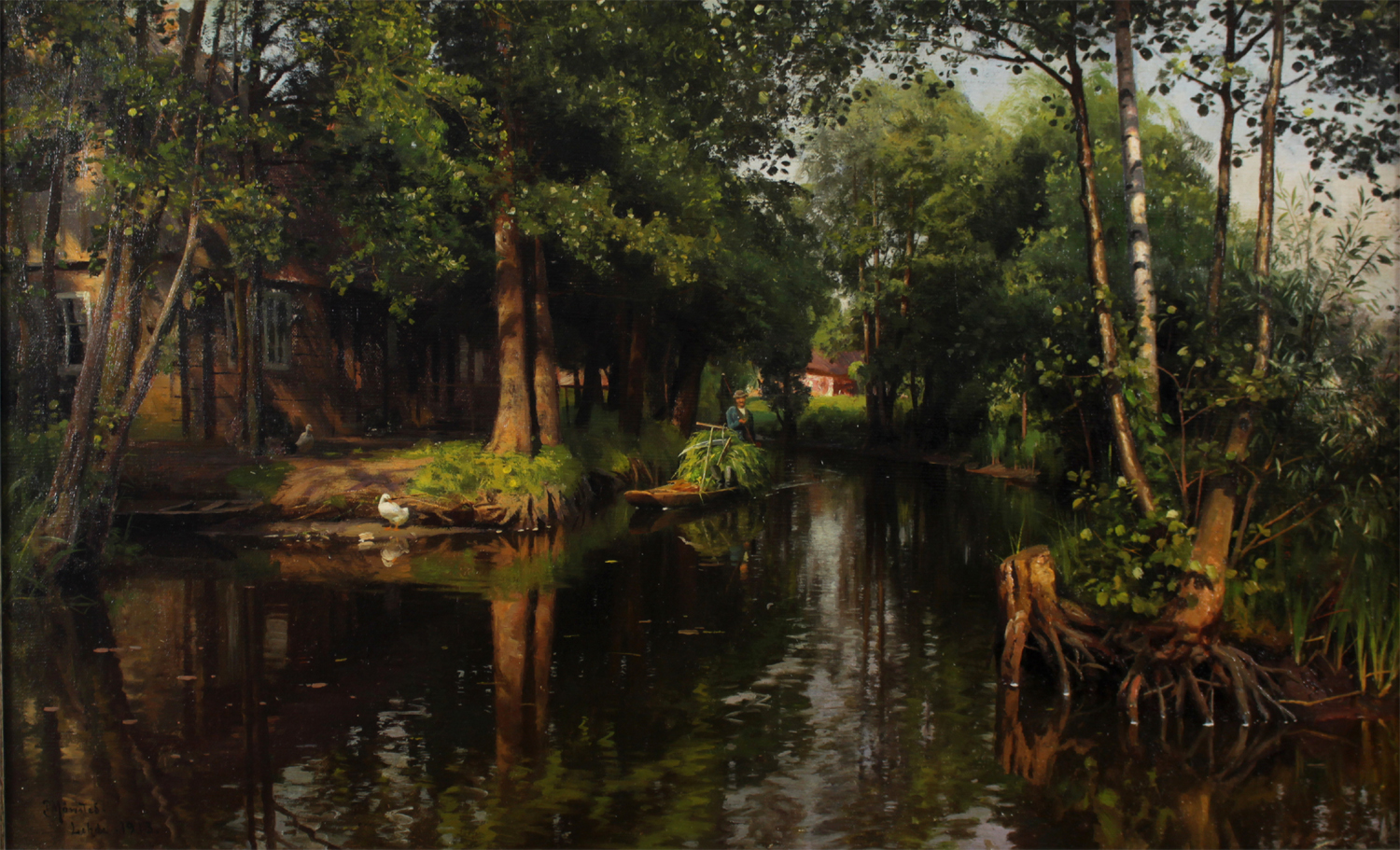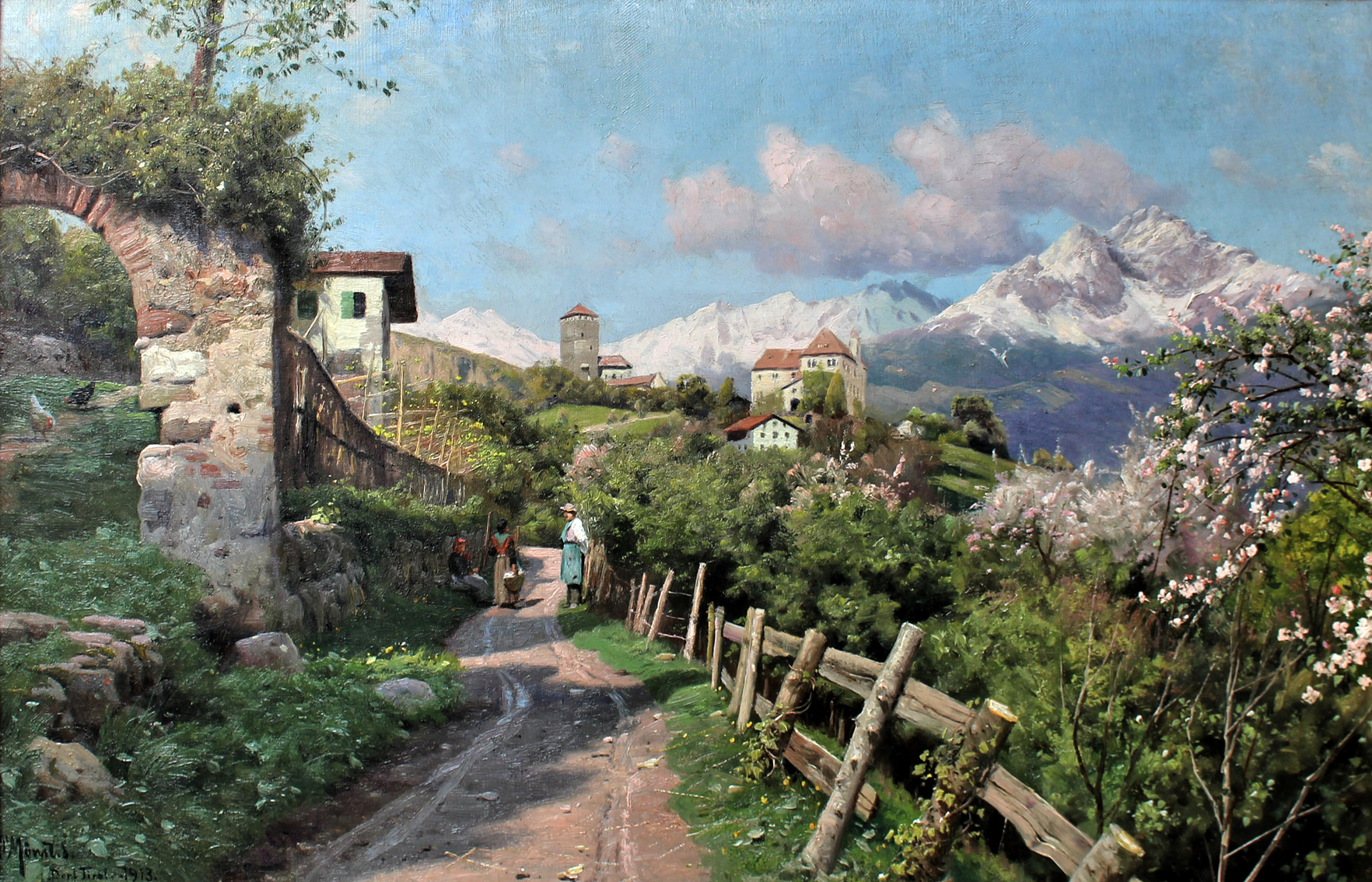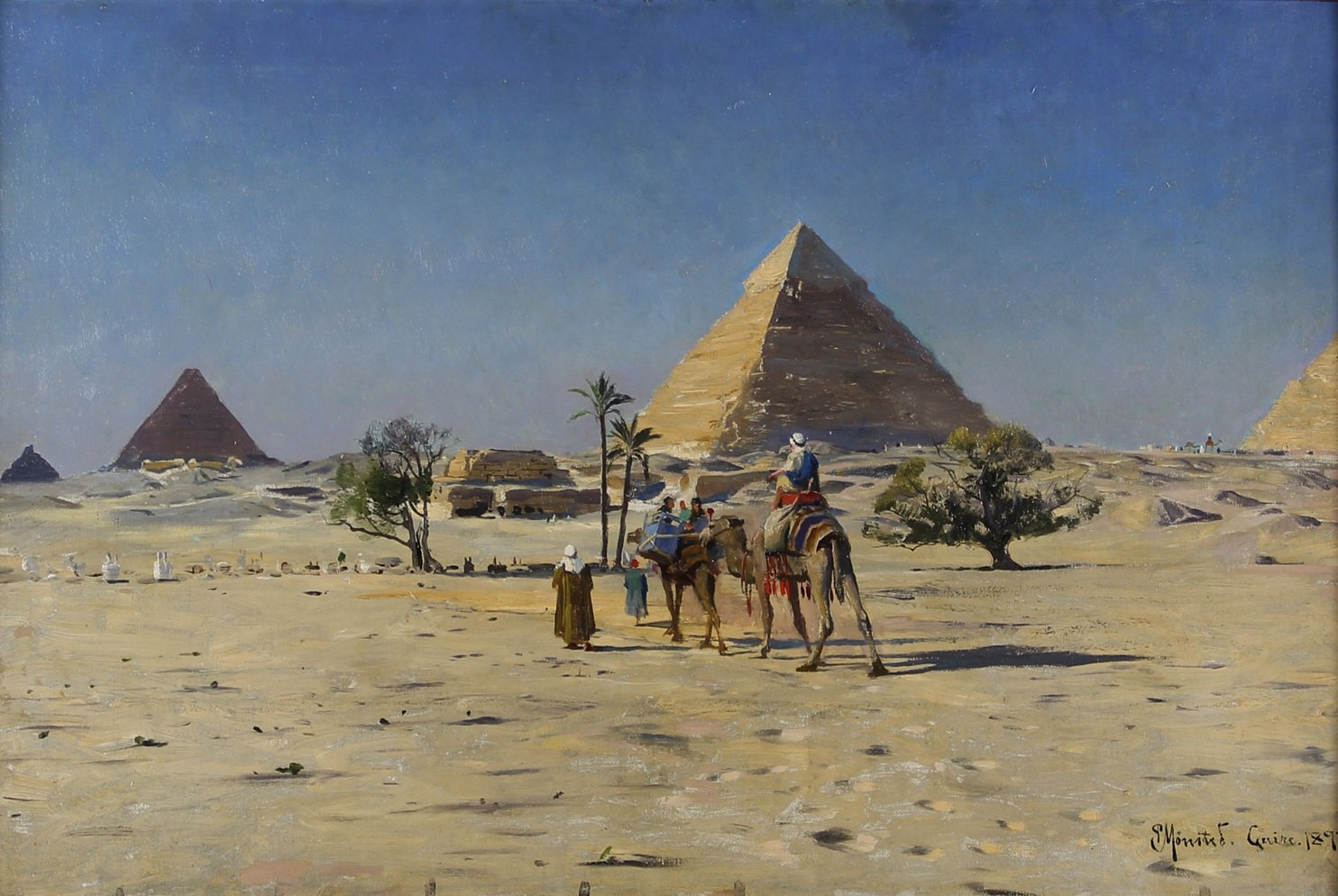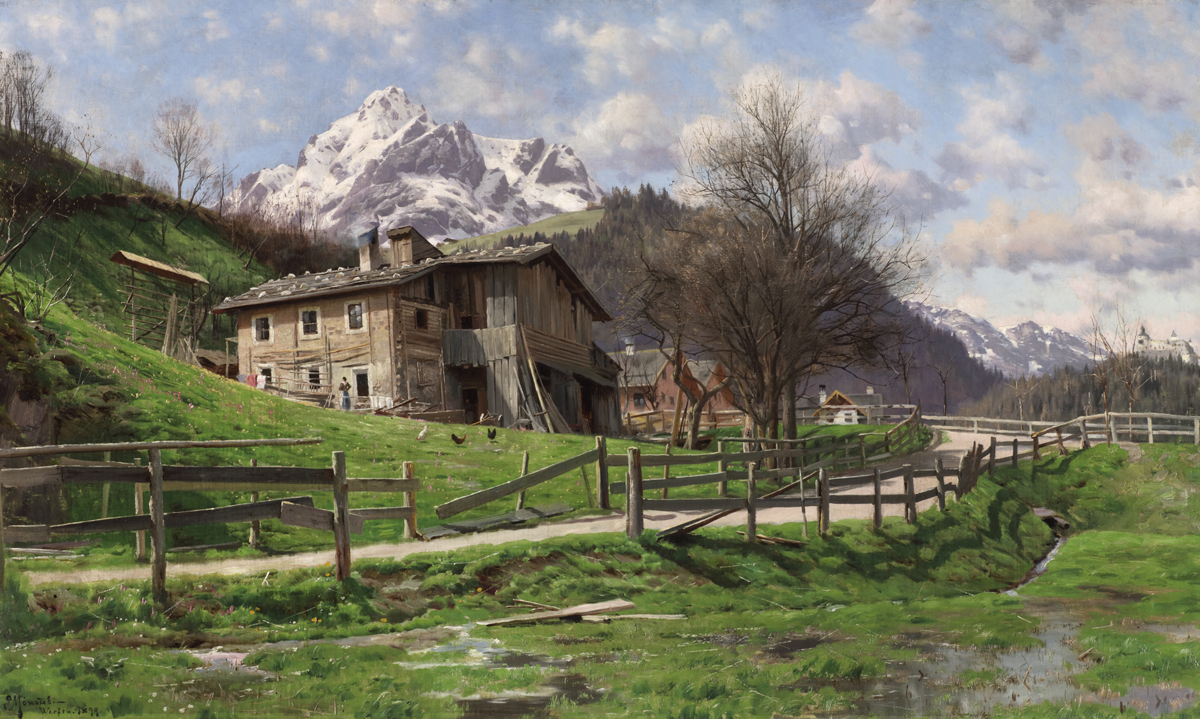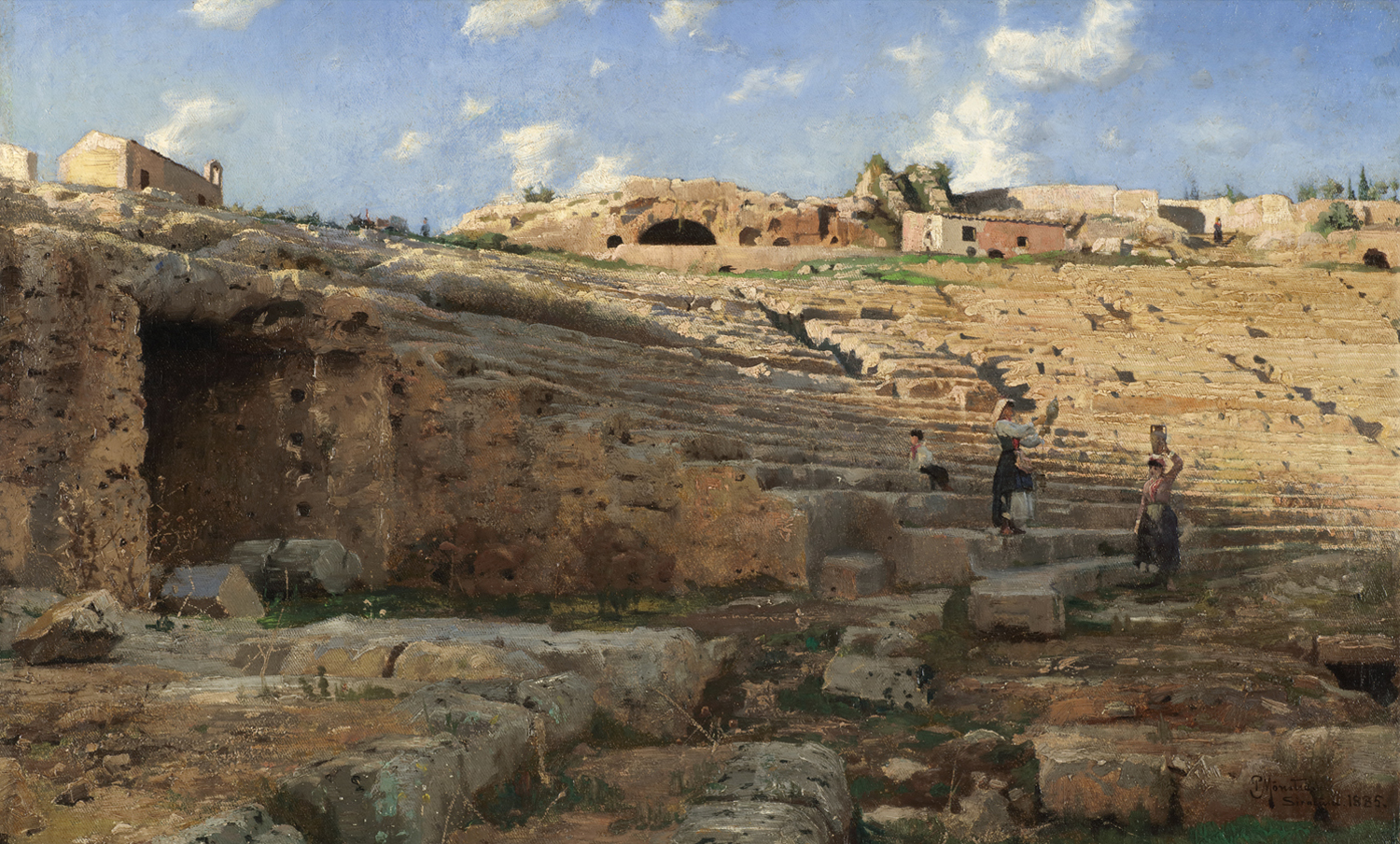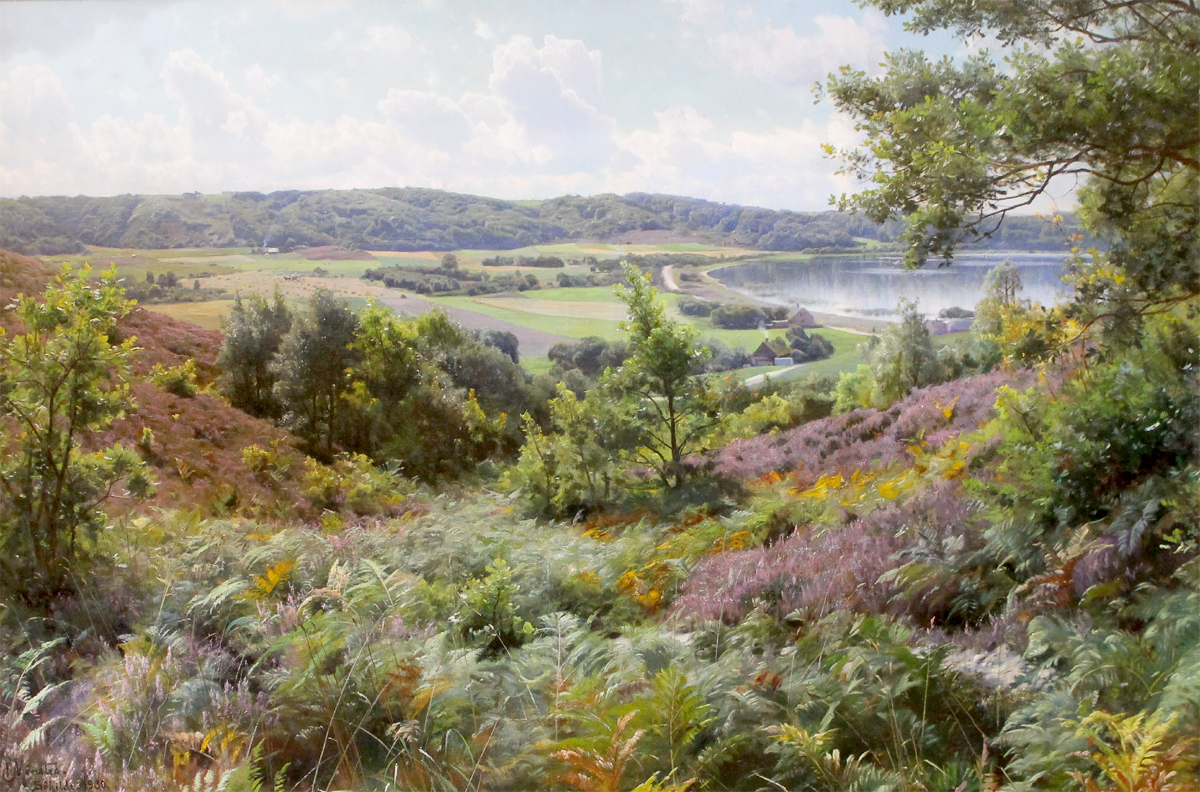Peder M. Monsted (Danish 1859-1941)
A Swiss Lake with Mountains in the Distance
oil on canvas, laid on cardboard, signed and dated lower right "P. Monsted 1889"
Size: 6 h x 10 ½ w in (with frame 12 ¾ h x 17 ¼ w)
J20726
Peder M. Monsted (Danish 1859-1941)
Street View In Garmisch, Upper Bavaria
oil on canvas, signed dated and inscribed lower right "P. Monsted Garmisch 1913" and inscribed on reverse "22. Gadi I Garmisch. Oberbayern"
Size: 19 3/4 h x 14 w in
J20639
Peder M. Monsted (Danish 1859-1941)
Frederiksborg Castle Garden on a Summer Day 1914
oil on canvas laid on cardboard, signed and dated lower right "P. Monsted 1914"
Size: 13 ¾ h x 20 ½ w in
J20627
Peder M. Monsted (Danish, 1859-1941)
Munkebjerg
oil on canvas, signed, inscribed and dated lower left "P. Monsted, Munkebjerg 1920"
Size in inches: 10 h x 14.5 w
J196
Peder M. Monsted (Danish 1859-1941)
Street View From Capri With The Bay Of Naples And A Smoking Vesuvius In The Distance
oil on canvas, signed, inscribed and dated lower right "P Monsted Capri 1885"
Size: 14.5 x 18 in
J20244
Peder M. Monsted (Danish 1859-1941)
View Of Knudsø From Tørring Heather Hills
oil on canvas, signed, dated and inscribed lower left " P. Monsted Torring 1929"
Size: 19 ¾ x 27 ½ in (with frame 27 x 35 in)
J19706
Peder M. Monsted (Danish 1859-1941)
A Summer Day, 1902
oil on canvas, signed and dated lower left "P. Monsted 1902"
This a very peaceful painting, superbly painted with all of the finest elements from Monsted and dated 1902 which was his best period. It is a key picture from when Denmark was in a very peaceful time. The subject depicts a young girl with cows, painted with fine detail, with wonderful water and reflections as well as the unique light of which Monsted is a master. The atmosphere is amazingly tranquil. The painting is complete with a very nice original gilded frame richly carved with oak leaves and acorns.
Size: 23 ¾ x 39 ¼ (with frame 36 x 52 in)
J20111
Peder M. Monsted (Danish 1859-1941)
A View of a Forest Glade with Deer in Dyrehaven Park
oil on canvas, signed and dated lower right with monogram "PM 79"
Size: 19 x 30 in (with frame 26 x 36 in)
J20128
Peder M. Monsted (Danish 1859-1941)
View Over Juul Lake
oil on canvas, signed, dated and inscribed lower right "P.Monsted Himmelbjergit 1927", signed on artist label and inscribed in pencil on the stretcher bar 'Udsigt fra H.C. Andersens bank (Himmelbjergit)'Exhibited at Charlottenborg in 1928.
Size: 35 ¾ x 53 ½ in (with frame 40 ¾ x 63 ½ in)
J17986
Peder M. Monsted (Danish 1859-1941)
Spring Thaw, Jondalselven, Telemark, 1935
oil on canvas signed, dated and inscribed lower right " P. Mønsted Jondalselven Telemark 1935", "Aprildag med Tøbrud. Jondalselven. Telemark" (April Day with Spring Thaw. Jondalselven (the river of Jondal), Telemark, Norway)
Exhibited: Charlottenborg 1935 no. 377, reproduced p. 122
Size: 48 x 63 ¼ in (with frame 58 x 71 ¼ in)
J19539
Peder M. Monsted (Danish 1859-1941)
Fishing, Northern Italy
oil on canvas, signed lower right "P Monsted"
Size: 12 ¼ x 20 ¼ in (with frame 20 ½ x 28 ½ in)
J19721
SELECT SOLD
Peder M. Monsted (Danish 1859-1941)
View of Lake, Vevey
oil on board, signed and dated lower right "P. Monsted 1890", inscribed lower left "Vevey"
Size: 6 3/4 x 10 1/2 in (with frame 15 1/2 x 19 1/4")
J14876
SOLD
This item is no longer available, please contact us to inquire about similar pieces.
uno@langmann.com
604 736 8825 or 1 800 730 8825
Peder M. Monsted (Danish 1859-1941)
Torbole, Italy
oil on canvas. signed, dated, and inscribed lower left "P. Mønsted Torbole 1932"
Size: 19 ¾ x 27 ½ in (with frame 25 ½ x 33 ¼ in)
J17935
SOLD
This item is no longer available. Please contact us to inquire about similar pieces.
uno@langmann.com
604 736 8825 or 1 800 730 8825
Peder M. Monsted (Danish 1859-1941)
Still Water, Summer, 1894
oil on canvas, signed and dated "P. Monsted 1894"
Size: 33 ½ x 49 ½ in (with frame 39 x 56 in)
J19548
SOLD
This item is no longer available. Please contact us to inquire about similar pieces.
uno@langmann.com
604 736 8825 or 1 800 730 8825
Peder M. Monsted (Danish 1859-1941)
First Blush of Spring
oil on canvas, signed and dated lower right "P. Monsted 1901"
This is a magnificent example of Peder Monsted's mastery of both light and shallow water. A nice early work (1901) with exceptional light, fresh colours, crispness and spring forest beech leaves, you feel like walking into the distant, clean landscape.
Size: 32 ¾ x 47 ¼ in (with frame 47 x 61 in)
J19656
Peder M. Monsted (Danish 1859-1941)
Peaceful Water, Beech Forest
oil on canvas, signed and dated lower left "P. Monsted, 1906"
Size: 28 ¾ x 21 in
J19911
SOLD
This item is no longer available, please contact us to inquire about similar pieces.
604 736 8825 or 1 800 730 8825
Peder M. Monsted (Danish 1859-1941)
Evening at Susåen - Næsbyholm
oil on mahogany panel, signed and dated lower left “P. Mönsted 1901", with dedication lower right "Til min ven Kammersanger Simmonsen" (To my friend Chamber singer Simmonsen) and inscribed on back "Aften vid Susåen - Næsbyholm"
Size: 9 x 12 ¾ in (with frame 14 ½ x 18 in)
J19570
SOLD
This item is no longer available, please contact us to inquire about similar pieces.
604 736 8825 or 1 800 730 8825
Peder M. Monsted (Danish 1859-1941)
A Clearing in The Forest at a Stream with Harvest Workers
oil on canvas, signed, dated and inscribed lower left "P. Mønsted Sorgenfri 1886"
Size: 28 x 24 ¾ in (with frame 41 x 37 in)
J19541
SOLD
This item is no longer available, please contact us to inquire about similar pieces.
604 736 8825 or 1 800 730 8825
Peder M. Monsted (Danish 1859-1941)
Late Spring Day in Vallensbæk
oil on canvas, signed, inscribed and dated lower right "P. Mønsted Vallensbæk 1922"
Size: 20 x 29 in (with frame 28 x 37 ¼ in)
J19540
SOLD
This item is no longer available, please contact us to inquire about similar pieces.
604 736 8825 or 1 800 730 8825
Peder M. Monsted (Danish 1859-1941)
Picking Flowers
oil on canvas, signed and dated lower left "P. Monsted 1902"
Size: 19 ¾ x 27 ½ in (with frame 30 ¼ x 38 ¼ in)
J19502
SOLD
This item is no longer available, please contact us to inquire about similar pieces.
604 736 8825 or 1 800 730 8825
Peder M. Monsted (Danish 1859-1941)
Fishing from a Punt
oil on canvas, signed, dated and inscribed lower right " P. Monsted, Eiche. 1910"
Size: 28 x 39 ½ in (with frame 33 ¾ x 45 ¼)
J19456
SOLD
This item is no longer available, please contact us to inquire about similar pieces.
604 736 8825 or 1 800 730 8825
Peder M. Monsted (Danish 1859-1941)
Summer's Day in the Spreewald
oil on canvas, signed, dated and inscribed lower left "P. Monsted Lehde 1913"
Size in inches: 20.75 h x 33.25 w (with frame 26 1/2" x 39 1/4")
J19454
SOLD
This item is no longer available, please contact us to inquire about similar pieces.
604 736 8825 or 1 800 730 8825
Peder M. Monsted (Danish 18599-1941)
Spring Landscape in Tyrol 1913
oil on canvas, signed dated and inscribed lower left "P. Monsted Dorf Tirol 1913"
Size: 17 ¾ x 24 ½ in (with frame 20 ¼ x 28 ½ in)
J19242
SOLD
This item is no longer available, please contact us to inquire about similar pieces.
604 736 8825 or 1 800 730 8825
Peder M. Monsted (Danish 1859-1941)
Early Spring 1896
oil on lined canvas, signed and dated lower right " P. Monsted 1896"
Size: 22 ½ x 43 ½ in (with frame 32 x 52 ¾ in)
J19231
SOLD
This item is no longer available, please contact us to inquire about similar pieces.
604 736 8825 or 1 800 730 8825
Peder M. Monsted (Danish 1859-1941)
View of Giza Pyramids Outside Cairo
oil on lined canvas, signed and dated lower right " P. Monsted Cairo 1893"
Size: 16 x 24 ¾ in (with frame 22 ¾ x 31 in)
J19227
SOLD
This item is no longer available, please contact us to inquire about similar pieces.
604 736 8825 or 1 800 730 8825
Peder M. Monsted (Danish 1859-1941)
Summer Scenery with a Family Relaxing near a Serpentine Stream
oil on lined canvas, signed and dated lower right " P. Monsted 86"
Size: 8 ½ x 13 in (with frame 14 x 18 ½ in)
J19226
SOLD
This item is no longer available, please contact us to inquire about similar pieces.
604 736 8825 or 1 800 730 8825
Peder M. Monsted (Danish 1859-1941)
Landscape with Farm in Werfen
oil on canvas, signed, inscribed and dated lower left "P. Monsted, Werfen 1899"
Size: 26 ¾ x 45 ¼ in (with frame 40 x 60 in)
J19184
SOLD
This item is no longer available, please contact us to inquire about similar pieces.
604 736 8825 or 1 800 730 8825
Peder Monsted (Danish 1859-1941)
Syracuse Amphitheater
oil on canvas, signed and dated lower right "P. Monsted 1885"
Size: 23 x 36½ in (with frame 29 x 43 ¼ in)
J19114
SOLD
This item is no longer available, please contact us to inquire about similar pieces.
604 736 8825 or 1 800 730 8825
Popular throughout Europe and Africa throughout his career, Peder Mønsted clearly established himself as Denmark's greatest landscape artist for his supreme technical abilities, strong compositions and meditative peacefulness. His brushwork varied from very loose and Impressionist to a neatly detailed attention that served to heighten the sensation of presence.
Peder Monsted was born in Balle Molle, near Grenaa, Denmark, in December 1859. He died at Fredensborg in June 1941. His urn rests at Garnisons Kirkegard, an old cemetery in Copenhagen where many prominent Danish people are buried. He was the son of Otto Christian Monsted who was a shipbuilder, photographer and collector for the National lottery, and Thora Johanne Petrea Jorgensen. He married Elna Mathilde Marie Sommer in Frederiksberg in 1889.
Monsted’s art teacher at school was Andreas Fritz (1828-1906), who was to prove an important influence on his work. He studied at the Prince Ferdinand School of art in Aarhus, and was accepted at the Royal Academy of Art in Copenhagen, attending preparatory classes in October 1875. There, Monsted was taught by Frederik Vermeheren (1823-1910), Julius Exner (1825-1910) and Niels Simonsen (1807-1885). This generation of artists turned away from the prevailing style of Dusseldorf romanticism and veered towards a nationalistic consciousness, which resulted in the creation of a new peasant genre. Monsted left the Academy in 1879 without taking his final examinations. For a time he also studied under the most original artist of the period, Peder Severin Kroyer (1851-1909), whose painting inspired all around him with magical interpretations of light and air.
Monsted’s talent as a landscape artist developed during a summer holiday in Jutland under the particular guidance of his first teacher Andreas Fritz. The influence of earlier landscape artists, including Otto Bache, Janus la Cour, Godfred Christensen, Thorvald Niss and Knud Larsen, then became visible.
Monsted traveled extensively. In 1882 he visited Capri and Switzerland, continuing to Paris in 1883. During his stay in Paris he worked for four months with William Adolphe Bouguereau (1825-1905), an unbending traditionalist of leading importance at the Salon, who nevertheless did not inhibit the young artist’s eye for new ideas. After painting in Italy he traveled to Algiers in 1889 and on to Switzerland. In 1892 he boarded the Corvette St. Thomas, cruising the Mediterranean and subsequently becoming the personal guest of King George of Greece for six months. Later, he visited Egypt.
Monsted’s landscapes from Greece, Italy and North Africa painted before 1905 are very highly regarded. They show a very varied observation of the nature and a fine sense of the changing light and colour conditions.
Making his home in Denmark, Monsted continued to travel throughout his career: Monaco, 1902; Menton 1906; Lillehammer 1916; Ravello 1926; Venice 1928; and the Engadin Mountains in 1933. He was primarily a landscape artist but also painted several notable portraits including King George of Greece.
Monsted shows a distinctive approach to nature, his technique broadening with the years yet persisting in a perfect sense of balance and clarity of light which touches the essentials of each locality with simplicity.
He contributed to numerous exhibitions from 1874 until his death in 1941, of which the following venues are recorded:
the December exhibition at Charlottenborg, 1874, and then continuously between 1879-1941
the Autumn exhibition at Charlottenborg, 1922 and 1931
the Art Society of 1st November, 1882, 1921, 1931, 1925-1932, 1937 and 1942
the Nordic exhibition, 1883 and 1888
Kleist Kunsthandel, Copenhagen, 1892
Lubeck, 1895
Copenhagen Town Hall, 1901
Aarhus Society of Art, 1909, 1919, 1928
Studio exhibitions, 1921, 1923-24, 1926, 1927, 1930-36
the Glaas Palace in Munich
the Salon in Paris
Apart from many important collections, paintings by Monsted are in the Aalborg Museum, the Collection of Queen Alexandrine, The National Gallery, Copenhagen, and the Randers Museum.










